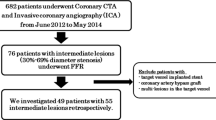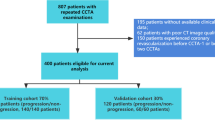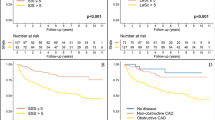Abstract
Purpose
To provide comparative prognostic information of coronary atherosclerotic plaque volume and stenosis assessment in patients with suspected coronary artery disease (CAD).
Methods
We followed 372 patients with suspected or known CAD enrolled in the CORE320 study for 2 years after baseline 320-detector row cardiac CT scanning and invasive quantitative coronary angiography (QCA). CT images were analyzed for coronary calcium scanning (CACS), semi-automatically derived total percent atheroma volume (PAV), segment stenosis score (SSS), in addition to traditional stenosis assessment (≥ 50%) by CT and QCA for (1) 30-day revascularization and (2) major adverse cardiac events (MACE). Area under the receiver operating characteristic curve (AUC) was used to compare accuracy of risk prediction.
Results
Sixty percent of patients had obstructive CAD by QCA with 23% undergoing 30-day revascularization and 9% experiencing MACE at 2 years. Most late events (20/32) were revascularization procedures. Prediction of 30-day revascularization was modest (AUC range 0.67–0.78) but improved after excluding patients with known CAD (AUC range 0.73–0.86, p < 0.05 for all). Similarly, prediction of MACE improved after excluding patients with known CAD (AUC range 0.58–0.73 vs. 0.63–0.77). CT metrics of atherosclerosis burden performed overall similarly but stenosis assessment was superior for predicting 30-day revascularization.
Conclusions
Angiographic and coronary atherosclerotic plaque metrics perform only modestly well for predicting 30-day revascularization and 2-year MACE in high risk patients but improve after excluding patients with known CAD. Atherosclerotic plaque metrics did not yield incremental value over stenosis assessment for predicting events that predominantly consisted of revascularization procedures.
Clinical Trial Registration: NCT00934037.


Similar content being viewed by others
Availabilityof data and material
Data belongs to the sponsor and may be provided on request at the discretion of the sponsor.
References
Arbab-Zadeh A, Fuster V (2016) The risk continuum of atherosclerosis and its implications for defining CHD by coronary angiography. J Am Coll Cardiol 68:2467–2478
Nakagomi A, Celermajer DS, Lumley T, Freedman SB (1996) Angiographic severity of coronary narrowing is a surrogate marker for the extent of coronary atherosclerosis. Am J Cardiol 78:516–519
Kalra DK, Heo R, Valenti V, Nakazato R, Min JK (2014) Role of computed tomography for diagnosis and risk stratification of patients with suspected or known coronary artery disease. Arterioscler Thromb Vasc Biol 34:1144–1154
Boogers MJ, Broersen A, van Velzen JE et al (2012) Automated quantification of coronary plaque with computed tomography: comparison with intravascular ultrasound using a dedicated registration algorithm for fusion-based quantification. Eur Heart J 33:1007–1016
Nakazato R, Shalev A, Doh JH et al (2013) Aggregate plaque volume by coronary computed tomography angiography is superior and incremental to luminal narrowing for diagnosis of ischemic lesions of intermediate stenosis severity. J Am Coll Cardiol 62:460–467
Kishi S, Magalhaes TA, Cerci RJ et al (2016) Total coronary atherosclerotic plaque burden assessment by CT angiography for detecting obstructive coronary artery disease associated with myocardial perfusion abnormalities. J Cardiovasc Comput Tomogr 10:121–127
Vavere AL, Simon GG, George RT et al (2011) Diagnostic performance of combined noninvasive coronary angiography and myocardial perfusion imaging using 320 row detector computed tomography: design and implementation of the CORE320 multicenter, multinational diagnostic study. J Cardiovasc Comput Tomogr 5:370–381
Rochitte CE, George RT, Chen MY et al (2014) Computed tomography angiography and perfusion to assess coronary artery stenosis causing perfusion defects by single photon emission computed tomography: the CORE320 study. Eur Heart J 35:1120–1130
Morise AP, Haddad WJ, Beckner D (1997) Development and validation of a clinical score to estimate the probability of coronary artery disease in men and women presenting with suspected coronary disease. Am J Med 102:350–356
George RT, Arbab-Zadeh A, Cerci RJ et al (2011) Diagnostic performance of combined noninvasive coronary angiography and myocardial perfusion imaging using 320-MDCT: the CT angiography and perfusion methods of the CORE320 multicenter multinational diagnostic study. AJR Am J Roentgenol 197:829–837
Min JK, Shaw LJ, Devereux RB et al (2007) Prognostic value of multidetector coronary computed tomographic angiography for prediction of all-cause mortality. J Am Coll Cardiol 50:1161–1170
Miller JM, Dewey M, Vavere AL et al (2009) Coronary CT angiography using 64 detector rows: methods and design of the multi-centre trial CORE-64. Eur Radiol 19:816–828
Agatston AS, Janowitz WR, Hildner FJ, Zusmer NR, Viamonte M Jr, Detrano R (1990) Quantification of coronary artery calcium using ultrafast computed tomography. J Am Coll Cardiol 15:827–832
de Graaf MA, Broersen A, Kitslaar PH et al (2013) Automatic quantification and characterization of coronary atherosclerosis with computed tomography coronary angiography: cross-correlation with intravascular ultrasound virtual histology. Int J Cardiovasc Imaging 29:1177–1190
Boogers MJ, Schuijf JD, Kitslaar PH et al (2010) Automated quantification of stenosis severity on 64-slice CT: a comparison with quantitative coronary angiography. JACC Cardiovasc Imaging 3:699–709
de Graaf MA, Broersen A, Ahmed W et al (2014) Feasibility of an automated quantitative computed tomography angiography-derived risk score for risk stratification of patients with suspected coronary artery disease. Am J Cardiol 113:1947–1955
Chang HJ, Lin FY, Lee SE et al (2018) Coronary atherosclerotic precursors of acute coronary syndromes. J Am Coll Cardiol 71:2511–2522
Arbab-Zadeh A, Fuster V (2015) The myth of the vulnerable plaque - transitioning from a focus on individual lesions to atherosclerotic disease burden for coronary artery disease risk assessment. J Am Coll Cardiol JACC 65:846–855
Herzog C, Kerl JM, De Rosa S et al (2013) Influence of observer experience and training on proficiency in coronary CT angiography interpretation. Eur J Radiol 82:1240–1247
Papadopoulou SL, Garcia-Garcia H, Rossi A et al (2013) Reproducibility of computed tomography angiography data analysis using semiautomated plaque quantification software: implications for the design of longitudinal studies. Int J Cardiovasc Imaging 29:1095–1104
Cho I, Chang HJ, Sung JM et al (2012) Coronary computed tomographic angiography and risk of all-cause mortality and nonfatal myocardial infarction in subjects without chest pain syndrome from the CONFIRM registry (coronary CT angiography evaluation for clinical outcomes: an international multicenter registry). Circulation 126:304–313
Al-Mallah MH, Qureshi W, Lin FY et al (2014) Does coronary CT angiography improve risk stratification over coronary calcium scoring in symptomatic patients with suspected coronary artery disease? Results from the prospective multicenter international CONFIRM registry. Eur Heart J Cardiovasc Imaging 15:267–274
Funding
The sponsor of the CORE320 study, Canon (formerly Toshiba) Medical Systems Corporation, was not involved during any stage of the planning, design, data acquisition, data analysis, or manuscript preparation of this study.
Author information
Authors and Affiliations
Corresponding author
Ethics declarations
Conflict of interest
Dr. J.H.C. Reiber has a part-time appointment as Professor of Medical Imaging at the Leiden University Medical Center (LUMC) and is the CEO of Medis medical imaging systems, Leiden, the Netherlands. Dr. P. Kitslaar has a research appointment at the LUMC, Division of Image Processing (LKEB), Department of Radiology and is an employee of Medis, Leiden, the Netherlands. Drs. F. Rybicki and A. Arbab-Zadeh disclose their membership of the CORE320 steering committee. The CORE320 study was sponsored by Canon (formerlyToshiba) Medical Systems. Dr. George and Mrs. Vavere have joined AstraZeneca as employees since completion of this research but disclose no conflicts to this topic.
Ethical approval
Approval for all research activities were obtained from local and central institutional review boards.
Informed consent
All patients signed written consent to participate. Permission was obtained to publish the presented data.
Additional information
Publisher's Note
Springer Nature remains neutral with regard to jurisdictional claims in published maps and institutional affiliations.
Rights and permissions
About this article
Cite this article
Kishi, S., Magalhães, T.A., Cerci, R.J. et al. Comparative effectiveness of coronary artery stenosis and atherosclerotic plaque burden assessment for predicting 30-day revascularization and 2-year major adverse cardiac events. Int J Cardiovasc Imaging 36, 2365–2375 (2020). https://doi.org/10.1007/s10554-020-01851-3
Received:
Accepted:
Published:
Issue Date:
DOI: https://doi.org/10.1007/s10554-020-01851-3




